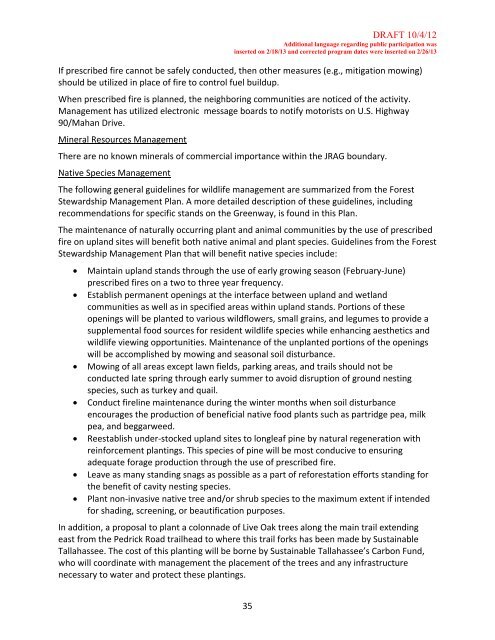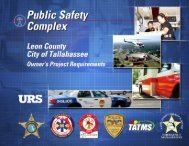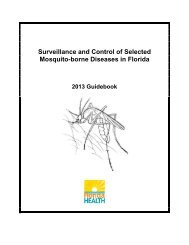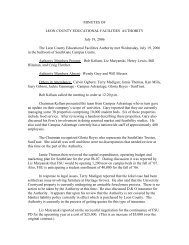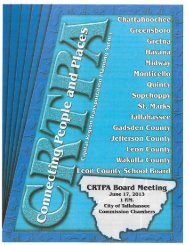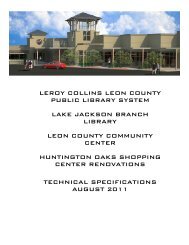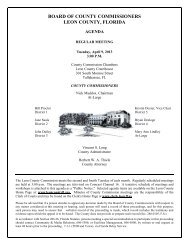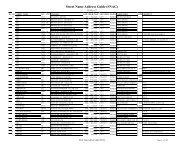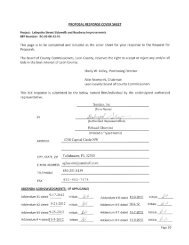J.R. Alford Greenway - Leon County
J.R. Alford Greenway - Leon County
J.R. Alford Greenway - Leon County
Create successful ePaper yourself
Turn your PDF publications into a flip-book with our unique Google optimized e-Paper software.
DRAFT 10/4/12<br />
Additional language regarding public participation was<br />
inserted on 2/18/13 and corrected program dates were inserted on 2/26/13<br />
If prescribed fire cannot be safely conducted, then other measures (e.g., mitigation mowing)<br />
should be utilized in place of fire to control fuel buildup.<br />
When prescribed fire is planned, the neighboring communities are noticed of the activity.<br />
Management has utilized electronic message boards to notify motorists on U.S. Highway<br />
90/Mahan Drive.<br />
Mineral Resources Management<br />
There are no known minerals of commercial importance within the JRAG boundary.<br />
Native Species Management<br />
The following general guidelines for wildlife management are summarized from the Forest<br />
Stewardship Management Plan. A more detailed description of these guidelines, including<br />
recommendations for specific stands on the <strong>Greenway</strong>, is found in this Plan.<br />
The maintenance of naturally occurring plant and animal communities by the use of prescribed<br />
fire on upland sites will benefit both native animal and plant species. Guidelines from the Forest<br />
Stewardship Management Plan that will benefit native species include:<br />
Maintain upland stands through the use of early growing season (February‐June)<br />
prescribed fires on a two to three year frequency.<br />
Establish permanent openings at the interface between upland and wetland<br />
communities as well as in specified areas within upland stands. Portions of these<br />
openings will be planted to various wildflowers, small grains, and legumes to provide a<br />
supplemental food sources for resident wildlife species while enhancing aesthetics and<br />
wildlife viewing opportunities. Maintenance of the unplanted portions of the openings<br />
will be accomplished by mowing and seasonal soil disturbance.<br />
Mowing of all areas except lawn fields, parking areas, and trails should not be<br />
conducted late spring through early summer to avoid disruption of ground nesting<br />
species, such as turkey and quail.<br />
Conduct fireline maintenance during the winter months when soil disturbance<br />
encourages the production of beneficial native food plants such as partridge pea, milk<br />
pea, and beggarweed.<br />
Reestablish under‐stocked upland sites to longleaf pine by natural regeneration with<br />
reinforcement plantings. This species of pine will be most conducive to ensuring<br />
adequate forage production through the use of prescribed fire.<br />
Leave as many standing snags as possible as a part of reforestation efforts standing for<br />
the benefit of cavity nesting species.<br />
Plant non‐invasive native tree and/or shrub species to the maximum extent if intended<br />
for shading, screening, or beautification purposes.<br />
In addition, a proposal to plant a colonnade of Live Oak trees along the main trail extending<br />
east from the Pedrick Road trailhead to where this trail forks has been made by Sustainable<br />
Tallahassee. The cost of this planting will be borne by Sustainable Tallahassee’s Carbon Fund,<br />
who will coordinate with management the placement of the trees and any infrastructure<br />
necessary to water and protect these plantings.<br />
35


